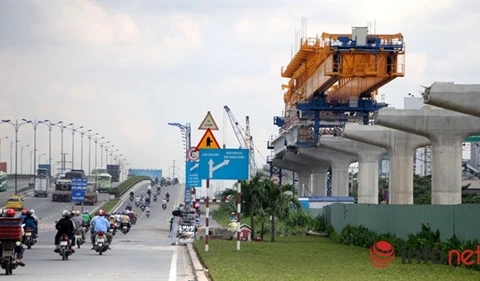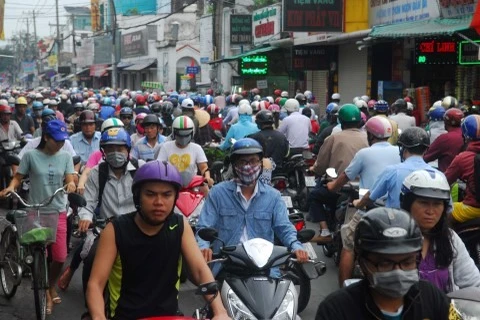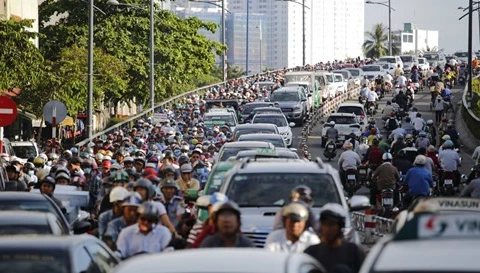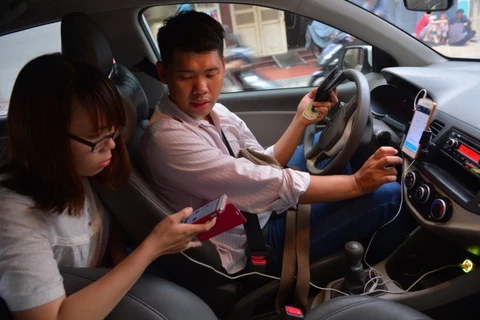HCM City (VNA) - Experts have called for more buses, bus routes and controls on private cars and motorcycles to help ease traffic congestions in Ho Chi Minh City.
The solutions debated at a recent forum in HCM City are part of a project initiated by the Transport Development and Strategy Institute.
Based on its research, project consultants recommended 19 measures to promote public transport, including those that will encourage use of green fuel and bus access for the disabled.
“Separate lanes for buses are necessary because now most buses still use the same roads with other vehicles. It’s not convenient and is unsafe,” they stressed.
“HCM City authorities should soon put the two river-bus routes from Binh Quoi to Bach Dang and from Bach Dang to Lo Gom into operation, and consider a railway system to connect Tan Son Nhat International Airport and Long Thanh International Airport,” the consultants added.
There are 142 bus routes in HCM City with nearly 3,000 buses, while Singapore has 990 routes and 21,152 buses, and Hong Kong has 992 routes and 17,554 buses.
Along with developing a public transport system, the experts at the event also noted that the city should focus on limiting the use of private vehicles.
They suggested that car access to downtown areas be limited to alternate days, based on license plate numbers, for example. Another proposal calls for fees to be imposed on all vehicles entering downtown districts and requiring vehicle users to register their cars and motorbikes every year at the districts where they live.
Parking fees should be high, and time limitation strictly enforced, the experts suggested, and the number of cars and motorbikes used for Grab and Uber services should be limited.
Environmental protection fees will be applied, which should help eliminate the use of old, exhaust-emitting vehicles.
Motorbike hire services, similar to those availabe for bike users in major world cities, should also be provided. From 2005 to 2016, the number of motorbikes has more than doubled, from nearly 3 million to 7.2 million, and is expected to reach 10 million by 2030.
“If we carry out all these suggestions in Hanoi and HCM City, I’m sure we can fully stop motorbike usage in some areas and streets by 2030,” expert Luong Hoai Nam was quoted as saying by the Tuoi Tre (Youth) newspaper.
“We must set a target of banning all motorbikes by 2030. To meet people’s transport demand, HCM City will need 21,000 buses, however, we have only 3,000,” said Dr. Pham Xuan Mai, former dean of the HCM City Politechnique University’s Transport Techniques Faculty.
The HCM City Transport Department will send 30,000 survey forms to households in all 24 of its districts, starting this month, with questions focusing on measures to reduce the use of private vehicles.
“The survey aims to collect more information about transport habits, demand and the views of local residents about transport infrastructure. Based on such information, related authorities will design a proper transport development roadmap,” Bui Xuan Cuong, Director of the Transport Department, said.
He also revealed that by November, the Department will complete its project to limit the use of private vehicles.-VNA
The solutions debated at a recent forum in HCM City are part of a project initiated by the Transport Development and Strategy Institute.
Based on its research, project consultants recommended 19 measures to promote public transport, including those that will encourage use of green fuel and bus access for the disabled.
“Separate lanes for buses are necessary because now most buses still use the same roads with other vehicles. It’s not convenient and is unsafe,” they stressed.
“HCM City authorities should soon put the two river-bus routes from Binh Quoi to Bach Dang and from Bach Dang to Lo Gom into operation, and consider a railway system to connect Tan Son Nhat International Airport and Long Thanh International Airport,” the consultants added.
There are 142 bus routes in HCM City with nearly 3,000 buses, while Singapore has 990 routes and 21,152 buses, and Hong Kong has 992 routes and 17,554 buses.
Along with developing a public transport system, the experts at the event also noted that the city should focus on limiting the use of private vehicles.
They suggested that car access to downtown areas be limited to alternate days, based on license plate numbers, for example. Another proposal calls for fees to be imposed on all vehicles entering downtown districts and requiring vehicle users to register their cars and motorbikes every year at the districts where they live.
Parking fees should be high, and time limitation strictly enforced, the experts suggested, and the number of cars and motorbikes used for Grab and Uber services should be limited.
Environmental protection fees will be applied, which should help eliminate the use of old, exhaust-emitting vehicles.
Motorbike hire services, similar to those availabe for bike users in major world cities, should also be provided. From 2005 to 2016, the number of motorbikes has more than doubled, from nearly 3 million to 7.2 million, and is expected to reach 10 million by 2030.
“If we carry out all these suggestions in Hanoi and HCM City, I’m sure we can fully stop motorbike usage in some areas and streets by 2030,” expert Luong Hoai Nam was quoted as saying by the Tuoi Tre (Youth) newspaper.
“We must set a target of banning all motorbikes by 2030. To meet people’s transport demand, HCM City will need 21,000 buses, however, we have only 3,000,” said Dr. Pham Xuan Mai, former dean of the HCM City Politechnique University’s Transport Techniques Faculty.
The HCM City Transport Department will send 30,000 survey forms to households in all 24 of its districts, starting this month, with questions focusing on measures to reduce the use of private vehicles.
“The survey aims to collect more information about transport habits, demand and the views of local residents about transport infrastructure. Based on such information, related authorities will design a proper transport development roadmap,” Bui Xuan Cuong, Director of the Transport Department, said.
He also revealed that by November, the Department will complete its project to limit the use of private vehicles.-VNA
VNA
























